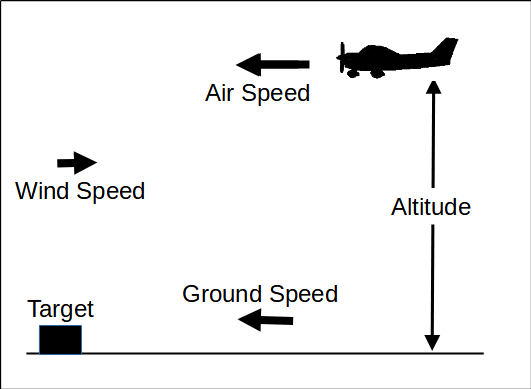Introduction

ground speed = air speed - wind speed
acceleration of gravity = 32 feet/sec/sec
Something to Think About
When the rock is released, its forward velocity immediately start slowing down due to air resistance.
Also its downward velocity would be effected by air resistance until it reaches terminal velocity.
Velocity is the speed of something in a given direction. in other words, it is speed and direction.
Denser air (closer to the ground) has more air resistance.
Wind speed generally varies with altitude. Wind speed close to the ground is generally slower that wind speed at altitude.
The terrain is generally not flat. (The altitude used in the calculations may be incorrect.)
Project #1
At what distance must you drop a rock from the airplane and hit the target?
Note: Use a simplified model. Ignore air resistance, variable wind speed, uneven terrain, ...
Create a program:
- ask the user for
- airplane altitude (feet)
- airplane speed1 (miles per hour)
- wind speed1 (miles per hour)
- calculate the time from the rock's release to hitting the ground
- calculate how far from the target you must release the rock to hit it
Project #2 (a more complex problem)
Destroy the airplane before it can bomb the target.
Combine the project
"How far will a cannon ball go? How high?"
 with Project #1.
with Project #1.
Assume the target has a cannon and shoots at the airplane. If the cannon ball and airplane comes within 100 ft of each other, the airplane is assumed to be destroyed.
Note: Use a simplified model. Ignore air resistance, variable wind speed, uneven terrain, ...
Create a program:
- ask the user for
- airplane altitude (feet)
- airplane speed1 (miles per hour)
- wind speed1 (miles per hour)
- cannon's muzzle velocity (feet per second)
- cannon's angle (degrees above the horizontal, maximum 90°)
-
Calculate the top of the cannon ball's arc and the airplane's
location. Adjust the game's parameters until you hit the airplane
(comes within 100 ft of each other).
Try the following steps:- Ignore the airplane. Adjust cannon's parameters so the top of the cannon ball's path is the airplane's altitude.
- Adjust the airplane's parameters so the airplane and cannon ball meet.
- How far away is the airplane (ground distance) when the cannon is fired?
- After the cannon is fired, how long (time) does it take for the cannon ball to hit the airplane?
- How far is the airplane (ground distance) from the cannon when it is hit by the cannon ball?
Useful Formulas
Finds the distance traveled (d) of an object with an initial velocity of zero, acceleration (a), and time (t) traveled. The equation used is
d = ½ * a * t2
Finds the distance traveled (d) of an object with an initial velocity (v), acceleration (a), and time (t) traveled. The equation used is
d = (v * t) + (½ * a * t2)